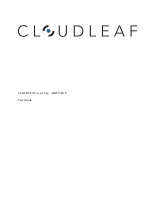
UBX-G7020 - Hardware Integration Manual
Design-in
GPS.G7-HW-10003
Objective Specification
Page 15 of 74
2.1.3
Built in supply monitors
Built-in supply voltage monitors ensure that the system always operates in safe regions. The following conditions
need to be met in order for the system to run properly:
1. The backup domain voltage LDO_B_OUT, the core domain voltage LDO_C_OUT and the RF domain voltage
LDO_RF_OUT need to be within specification. These voltages are supervised by POR_C, POR_B and POR_RF.
2. The I/O voltage VDD_IO needs to be within specification. This voltage is supervised by POR_IO. This supply
monitor has a configurable threshold. If external SQI flash is used the POR_IO threshold has to be set according
to the power supply voltage of the SQI Flash used to ensure that the system only starts when the supply voltage
for the SQI flash is reached. Otherwise, the system may fail to detect the external SQI flash and the SQI flash will
be ignored.
3. The clock domain voltage LDO_X_OUT needs to be within specification. This voltage is supervised by POR_X.
This supply monitor has a configurable threshold. If a TCXO is used the threshold has to be set according to the
supply or enable voltage of the TCXO supplied by LDO_X_OUT.
After release of POR_C the systems waits for 2048 clock cycles to occur before the clock signal is fed into the
core. This ensures system operation begins with a clean stable clock signal.
An additional supply monitor at pin VDD_IO, the VDD_IO_OK, switches the supply of the backup domain from
VDD_IO to V_BCKP, once VDD_IO falls below its operational specification. Thus, a separate supply source (at
V_BCKP) can be used to maintain RTC and backup RAM information even if VDD_IO fails.
2.1.4
Operating Modes
2.1.4.1
Continuous Mode
Continuous Mode uses the acquisition engine at full performance resulting in the shortest possible TTFF and the
highest sensitivity. It searches for all possible satellites until the Almanac is completely downloaded. The receiver
then switches to the tracking engine to reduce power consumption.
Thus, a lower tracking current consumption level will be achieved when:
A valid position is obtained
The entire Almanac has been downloaded
The Ephemeris for each satellite in view is valid
For best GNSS performance use Continuous Mode.
2.1.4.2
Power Save Mode
u-blox 7 GPS/ GNSS receivers include two Power Save Mode operations called ON/OFF and Cyclic tracking that
allow reducing the average current consumption in different ways to match the needs of the specific application.
Both operations can be set and configured by sending the corresponding UBX messages to the receiver. For
more information, please see the
u-blox 7 Receiver Description including Protocol Specification
In Power Save Mode, the supply voltages (V_CORE and VDD_IO) must remain inside operating conditions. The
system may shut down an optional external LNA by the ANT_ON signal to optimize the power consumption, see
section 2.6.2.2.
Use of the USB Interface is not recommended with Power Save Mode since the USB standard does not
allow a device to be non-responsive and hence must be continuously active. Thus it is not possible to
take full advantage of Power Save Mode operations in terms of saving current consumption.
Power Save Mode requires the RTC to be maintained. This can be achieved by connecting an external
RTC crystal or deriving the RTC via the main clock using the “single crystal” feature. - See section 2.5.
Confidential















































